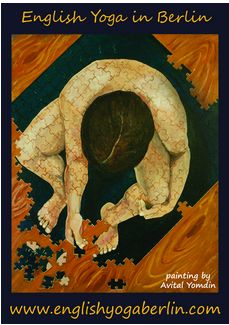People still look confused in class sometimes when I use yoga terminology. That’s why I started English Yoga terminology Tuesday. I guess I could always just use plain English in order to avoid these confusing moments, but as a person who enjoys looking up the etymology of words, how their meanings have evolved from what their original meanings were, and how words between different languages overlap- I would find it a shame not to introduce one of the oldest languages in the world in our classes (Sanskrit). So in this blog I would like to try and explain the meaning of one of the most common words used in my Berlin yoga classes. What is Pranayama?
Tag: Berlin Yoga
Berlin Yoga: Terminology Tuesday
 apes and sizes. Everything from the truly devout practices to the trendy, cult-like fashion of yoga- there are many styles and many different kinds of people practicing. Because there are so many people from all over the world who currently find this amazing city to be their home, we specialize in teaching Yoga in English. And because we believe that it can actually change lives, we teach the practices of Hatha Yoga and Vinyasa Yoga.
apes and sizes. Everything from the truly devout practices to the trendy, cult-like fashion of yoga- there are many styles and many different kinds of people practicing. Because there are so many people from all over the world who currently find this amazing city to be their home, we specialize in teaching Yoga in English. And because we believe that it can actually change lives, we teach the practices of Hatha Yoga and Vinyasa Yoga.
Berlin Yoga: Terminology Tuesday
As a teacher of Hath a Yoga in Berlin, I often use Sanskrit words in our classes when wanting to describe a pose or the reason behind something we are supposed to do. I try to always accompany these words with a translation, but every now and then I still see confused faces looking up at me. I realize that sometimes, especially when teaching yoga in English, it is important to not only describe the action in Sanskrit but to also offer a translation in plain English.
a Yoga in Berlin, I often use Sanskrit words in our classes when wanting to describe a pose or the reason behind something we are supposed to do. I try to always accompany these words with a translation, but every now and then I still see confused faces looking up at me. I realize that sometimes, especially when teaching yoga in English, it is important to not only describe the action in Sanskrit but to also offer a translation in plain English.
No matter how long you have taken yoga classes or how deep you are in your own personal practice, it’s important to understand the words being used over and over again. In an effort to explain the terms that many Berlin Yoga teachers (myself included) often take for granted that their students already understand, I am starting something I call Berlin Yoga: Terminology Tuesday. Each week we will be posting info about a term to help increase depth of understanding within your practice.
Perhaps the beginning is the best place to start….
Yoga: yolk (as in the yolk of an egg.)
The yolk of an egg has the capacity to bind ingredients together. Yoga also strives to bind or unite the three a spects of the self: the body, the mind and the soul. Over the centuries, it has become common for people to also translate the word yoga as “union”. And since the practice of Yoga affects people in so many different ways, the definitions of Yoga seem to be multiplying as yoga spreads throughout the world.
spects of the self: the body, the mind and the soul. Over the centuries, it has become common for people to also translate the word yoga as “union”. And since the practice of Yoga affects people in so many different ways, the definitions of Yoga seem to be multiplying as yoga spreads throughout the world.
What is a Sankalpa?
As an instructor of yoga in Berlin, I am often asked about the various parts ofthe practice I teach. One of the most recent questions was one coming from a new student in my Hatha yoga in English class. She asked. “What is a Sankalpa?”
Changing your life starts with setting the right intention. A Sankalpa is a very powerful tool that can help do just that.
Sankalpa is a Sanskrit word meaning resolve or resolution. It is a short, positive phrase that we use in order to build up an aspect of our character that needs strengthening. Take, for example, a person who wants to stop smoking. This person can very well understand all the reasons to stop smoking and even agree that being a non-smoker would be best for their health. But this understanding and agreement would be coming at the level of the intellect which is ruled solely by the conscious mind. And that is often not strong enough to take lasting action. By using the Sankalpa during relaxation, we have better access to the subconscious and have it work together with our conscious mind towards a common goal. This way the change that the Sankalpa brings into our lives is a more whole and permanent one.
My Berlin yoga class includes 70 minutes of positions and 20 minutes of relaxation and visualization in which we introduce aspects of yoga Nidra (conscious deep sleep). As we relax after yoga, we let go of our defenses, we become more vulnerable and the subconscious becomes more sensitive and receptive. That is the moment that we repeat our Sankalpa. When we first create our Sankalpa, we are planting a seed in our subconscious. Every time we go back to it and repeat it in our relaxed state, it is as if we were going back to it and watering it, caring for it so one day we can reap its fruits. For this reason, we keep the same Sankalpa until it becomes a reality in our lives.








